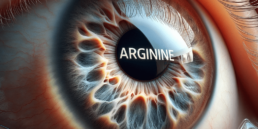
Lets talk about L-Arginine and Glaucoma.
L-Arginine is a semi-essential amino acid known for its role in synthesizing nitric oxide and for cardiovascular health. Recently it has gained attention for its potential benefits in eye health. Of import are it’s roles in managing conditions like glaucoma and nonarteritic ischemic optic neuropathy (rNAION). Because of recent updates in science, we felt in necessary to update our reads on the advancements.
This article will be delving into the recent studies that illuminate Arginine’s promising role in these common eye conditions. We also are looking into how L-Arginine and Glaucoma are linked. Because our products focus on Nitric Oxide, we feel our readers need to understand these potential benefits.
L-Arginine’s Mechanism in the Eye
Arginine is converted into nitric oxide (NO) by nitric oxide synthase in the body. NO plays a crucial role in ocular health, particularly in regulating intraocular pressure (IOP) and blood flow to the optic nerve. It is known to be an ocular hypotensive agent. This suggests it has great potential in managing conditions like glaucoma, where IOP is a critical factor.
Impact on Intraocular Pressure and Glaucoma
A recent study on human eyes showed that L-Arginine significantly reduced the mean Intraocular Pressure (IOP) during infusion. Researchers attribute this decrease mainly to Nitric Oxide (NO) formation. However, IOP rose after the infusion stopped, suggesting the effect is temporary. This result is crucial for glaucoma management. L-Arginine and Glaucoma are linked and are a potentially intriguing combination of nutritional element versus disease.
Broader Implications for Glaucoma
In 2002, Finnish researchers evaluated L-Arginine in reducing eye pressure in glaucoma patients. They found that L-Arginine-nitric oxide supplementation led to a drop in eye pressure. Similarly, in 2007, Austrian researchers studied its effect not on eye pressure but on the rate of blood flow reaching the optic nerve. Because of this study they discovered that the nitric oxide created from L-Arginine improved blood flow to the nerve. This shows promise in reducing the risk of nerve damage. However, as of 2011, L-Arginine was not yet a recognized treatment for optic nerve damage.
L-Arginine in rNAION Treatment
rNAION, characterized by a sudden, painless loss of vision, is associated with poor blood flow to the optic nerve. A study explored the effectiveness of L-Arginine in a rodent model of rNAION. Both intravenous infusion after rNAION induction and oral pretreatment with L-Arginine significantly decreased optic disc edema in the acute stage and reduced the thinning of the inner retina, as well as the decrease in the number of retinal ganglion cells (RGCs). This indicates that L-Arginine can reduce anatomical changes in the eye and improve visual function in the acute stage of rNAION.
Practical Considerations and Future Research
Future research is necessary to establish definitive guidelines for its use in various eye conditions. The potential of L-Arginine in eye health, as evidenced by these studies, is significant, but further clinical trials and investigations are crucial to fully understand and harness its benefits.
In Conclusion
L-Arginine presents a promising avenue for the management and treatment of eye conditions. Particularly glaucoma and rNAION. While current studies offer promising results, the full potential of L-Arginine in eye health remains to be unlocked through further research. Its role in synthesizing nitric oxide and improving blood flow and pressure within the eye points towards a future where it could become a key component in eye health management strategies.
References
- “The effect of L-arginine on intraocular pressure in the human eye” – https://pubmed.ncbi.nlm.nih.gov/10980664/.
- “L-Arginine and Glaucoma” – https://healthfully.com/l-arginine-and-glaucoma-7433644.html
- “Effects of L-arginine on anatomical and electrophysiological deterioration of the eye in a rodent model of nonarteritic ischemic optic neuropathy” – https://pubmed.ncbi.nlm.nih.gov/23712653/
